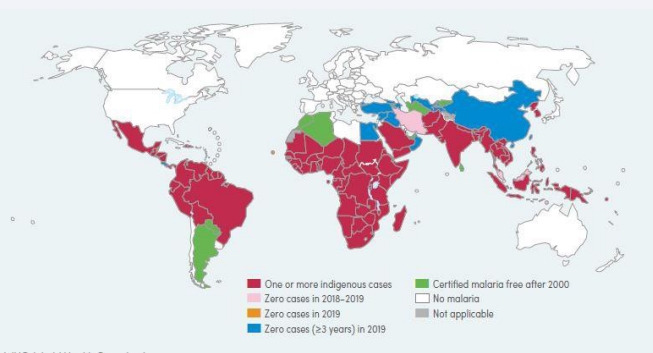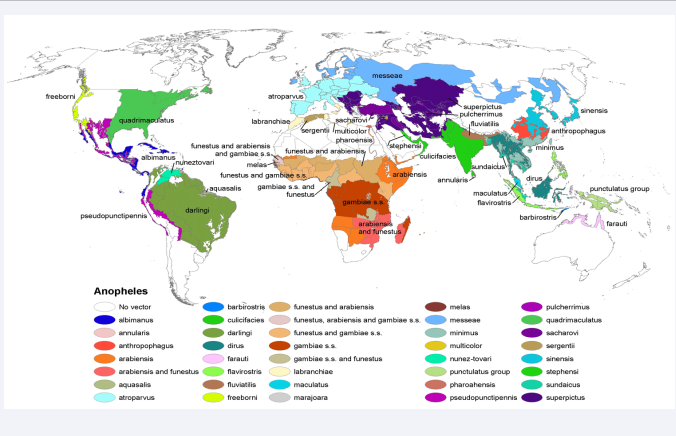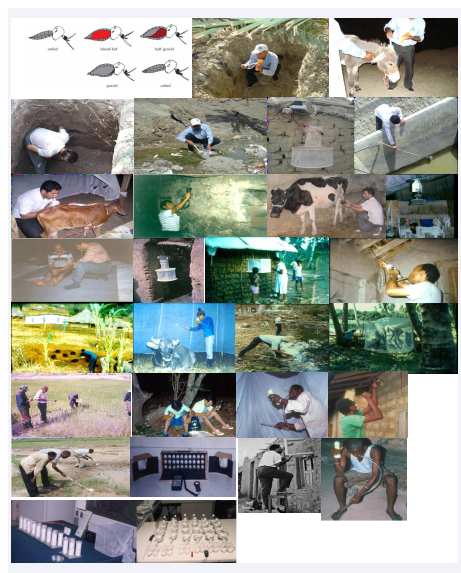Relevance of Entomological Services and Vector Control of Malaria within the Health System at the Different Levels and for the Different Phases
- 1. Department of Medical Entomology & Vector Control, School of Public Health, Tehran University of Medical Sciences, Iran
- 2. Department of Chemical Pollutants and Pesticides, Institute for Environmental Research, Tehran University of Medical Sciences, Iran
Abstract
Malaria is one of the most important mosquito-borne disease in the world. A total of 229 million malaria cases in 2019 in 87 malaria endemic countries and 384 000 malaria deaths reported by the WHO. There are several measures for control of vectors. Around 60 species of Anopheles species have been identified as vectors. WHO recommended several insecticides for control of vectors as Indoor residual spraying, Fogging, larviciding and impregnated bednets. In any control programme, entomological works play an important role either in the field studies as well as monitoring and evaluation of programme. The entomological surveillance in vector control will help the the health system at the different levels and for the different phases for appropriate control measures.
Keywords
• Malaria
• Entomological services
• Control
• Health system
CITATION
Vatandoost H (2024) Relevance of Entomological Services and Vector Control of Malaria within the Health System at the Different Levels and for the Different Phases. Ann Clin Pathol 11(1): 1169.
INTRODUCTION
Malaria is a parasitic disease that triggers fever, chills and a flu-like illness. Symptoms usually appear after a period of seven days or more after infection from a mosquito bite. Early diagnosis and treatment of malaria is key. If left untreated, the disease can lead to severe illness and death. The best available treatment, particularly for Plasmodium falciparum malaria, is artemisinin- based combination therapy (ACT). There is no commercially available vaccine against malaria although a promising vaccine against P. falciparum is currently being evaluated in a large clinical trial in seven African countries. Globally, there were an estimated 229 million malaria cases in 2019 in 87 malaria endemic countries and 384 000 malaria deaths, the WHO African Region accounted for about 94% of cases and deaths globally [1] (Figure 1).
Figure 1: Countries with indigenous cases in 2000 and their status by 2019.
Anopheline mosquitoes are the only vectors of the Plasmodium parasites. Each of the 60 known species of Anopheles that can transmit malaria has its own biological and ecological peculiarities [2] (Figure 2).
Figure 2: Global distribution of malaria vectors.
World Health Organization (WHO) recommended several measure for vector control using insecticides such as indoor residual spraying, Impregnate bed nets, fogging and larviciding [2].
In any control programme, entomological works play an important role either in the field studies as well as monitoring and evaluation of programme [4-6].
All the entomological activities should be parallel to that epidemiological data. The main important role of entomology in malaria control is conduction of strategy and tactics of vector control [7].
These role of entomology should be applicable in all phases of control. The type of entomological studies is different according to the malaria control programme at different epidemiological situations [8].
Principal of entomology and vector Control which should be carried out in all phases of malaria control programme are: evaluation of current malaria epidemiology situation, evaluation of current information about malaria vectors of the region and identifying main vectors, in the case of shortage or lack of information about malaria vectors, conduction a study to find the main malaria vector in the region, investigation on the resting and feeding behavior of malaria vectors, to understand which part of gonotrophic cycle happen in pesticide treatment houses, such investigation will provide information about selection of indicator areas for trend study of the disease through the transmission season, evaluation of density of the malaria vectors before and after pesticide application, investigation on the habit of population and its effect on malaria transmission, information collection on meteorological data, area topography and their effect on density and distribution of malaria vectors, to prepare a map of malaria vector distribution, to conduct the susceptibility test against different recommended pesticides as well as current use of pesticide, evaluation of residual effect of pesticide of sprayed surfaces, to calculate the amount of required insecticides for all treatment cycle, to estimate the appropriate time of pesticide application, the impact of residual spraying on malaria vector density, the impact of residual spraying on behaviour of vectors, to measure the impact of any intervention such as indoor residual spraying, using bednets on, biting habits and sprozoite rate of the vectors, to observe the variation or any change in the age of malaria vector population, to collect the data how the malaria control programme is going well or encountered with trouble, to estimate the time and number of application according to malaria transmission season, meteorological data and residual effect of pesticides, to calculate all the houses and dwelling should be sprayed, selection of research station for entomological studies during malaria control programme, estimation of all pesticide applicators, mosquito collectors and other personnel, analyzing the taxonomic information of malaria vectors, calculation of sporozite rate, calculation of man-biting rates for each human/night, calculation of antropophilic index, calculation of parous rate, preparing a map for malaria vector distribution at the larval and adult stages, survey on the feeding habit, oviposition sites and probable diapause, estimation on effective flight activity of vectors, estimation of effectiveness of vector control by pesticides, resting habits of vectors during the night, resting habits of vectors during the day, biological efficacy of sprayed surfaces, determination of susceptibility level of malaria vectors to pesticides [9].
Calculation of LC50, LT50 and if possible plotting the regression line for each insecticide, to find the probable mechanism of insecticide resistance [10,11]. conduction the irritability tests against pesticides, estimation of cost effectiveness of malaria control at either larval or adult stages, to map the larval distribution of malaria vectors, to map the larval breeding places, to evaluate the applicability of other control measures such as larval control, personal protection and biological control, the impact of control measures on the survival of vectors, to find the impact of pesticide on the exophilicity of vectors, to find the excito-repellency of pesticides, to find the correlation between entomological and parasitological data, continuous supervision on quality of application, continuous vigilance on the susceptibility level of vectors, vigilance on the occurrence of any change on behaviour of vectors due to intervention, to find the reasons why the control programme is not functioning as planned, to find the reduction on man-biting rate due to intervention, to estimate the survival rate due to intervention, to find any diversion of vector to another hosts, to find resistant population of vectors, conducting bioassay tests for residual effect of pesticides on sprayed surfaces or bednets, periodic and non-period survey on entomological date in research centers, conducting relevant workshop, courses for different levels of health workers, monitoring and mapping of insecticide resistance in the country and region, monitoring and evaluation of impact and outcome indicators for control measures.
The main methods for entomologist and vector control specialist for doing the above-mentioned studies are: hand catch collection, spay sheet collection, shelter pit collection, human bait collection, animal bait collection, light trap collection, animal baited trap collection, human baited trap collection, exit trap collection, hut studies, mosquito dissection for sporozoite, oocyst and parous rate, Elisa test for antropophilicity index, larval collection using dipper, serological studies, bioassay and susceptibility tests, irritability test, biochemical and molecular tests (Figure 3) [12].
Figure 3: The main methods for entomologist and vector control surveillance
REFERENCES
- World Health Organization (WHO). World malaria report. 2020; 300.
- Sato S. Plasmodium—a brief introduction to the parasites causing human malaria and their basic biology. J Physiol Anthropol. 2021; 40: 1.
- World Health Organization (WHO). Pesticides and their application for the control of vectors and pests of public health importance. 2006; 125.
- World Health Organization (WHO). Malaria Entomology and Vector Control. World Health Organization. 2013; 190.
- Alonso P, Noor AM. The global fight against malaria is at crossroads. Lancet. 2017; 390: 2532–2534.
- TDR (Special Programme for Research and Training in Tropical Diseases). Geneva: United Nations Children’s Fund, United Nations Development Programme, World Bank, World Health Organization. 2020.
- World Health Organization (WHO). Global plan for insecticide resistance management in malaria vectors. Geneva: World Health Organization. 2012.
- World Health Organization (WHO). Strategy for malaria elimination in the Greater Mekong subregion: 2015–2030. Geneva: World Health Organization. 2015.
- World Health Organization. Insecticide resistance. Geneva: World Health Organization. 2020.
- World Health Organization (WHO). Test procedures for insecticide resistance monitoring in malaria vector mosquitoes. Geneva: World Health Organization. 2018.
- World Health Organization (WHO). Insecticide resistance in malaria vectors. Geneva: World Health Organization. 2017.
- World Health Organization (WHO). Handbook for Integrated Vector Management (IVM). Geneva: World Health Organization. 2010; 78.











































































































































